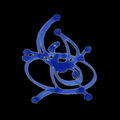Template:Selected anniversaries/September 30: Difference between revisions
No edit summary |
No edit summary |
||
| Line 31: | Line 31: | ||
||1916: Arthur Harold Stone born ... mathematician born in London, who worked mostly in topology. he proved the Erdős–Stone theorem with Paul Erdős and is credited with the discovery of the first 2 flexagons, a trihexaflexagon and a hexahexaflexagon. Pic: https://www.cambridge.org/core/journals/bulletin-of-the-london-mathematical-society/article/arthur-harold-stone-19162000/1E575AF918A66A3DEB8F902221CCAFC5 | ||1916: Arthur Harold Stone born ... mathematician born in London, who worked mostly in topology. he proved the Erdős–Stone theorem with Paul Erdős and is credited with the discovery of the first 2 flexagons, a trihexaflexagon and a hexahexaflexagon. Pic: https://www.cambridge.org/core/journals/bulletin-of-the-london-mathematical-society/article/arthur-harold-stone-19162000/1E575AF918A66A3DEB8F902221CCAFC5 | ||
||1925: Arkady Ostashev born ... engineer and educator. | ||1925: Arkady Ostashev born ... engineer and educator. Pic. | ||
File:Chiungtze C. Tsen 1932.jpg|link=Chiungtze C. Tsen (nonfiction)|1930: Mathematician and [[Gnomon algorithm]] theorist [[Chiungtze C. Tsen (nonfiction)|Chiungtze C. Tsen]] uses Tsen's theorem, which states that a function field K of an algebraic curve over an algebraically closed field is quasi-algebraically closed, to prevent the [[Forbidden Ratio]] gang from [[Crimes against mathematical constants|stealing the function field K]]. | File:Chiungtze C. Tsen 1932.jpg|link=Chiungtze C. Tsen (nonfiction)|1930: Mathematician and [[Gnomon algorithm]] theorist [[Chiungtze C. Tsen (nonfiction)|Chiungtze C. Tsen]] uses Tsen's theorem, which states that a function field K of an algebraic curve over an algebraically closed field is quasi-algebraically closed, to prevent the [[Forbidden Ratio]] gang from [[Crimes against mathematical constants|stealing the function field K]]. | ||
| Line 38: | Line 38: | ||
||1954: The U.S. Navy submarine USS Nautilus is commissioned as the world's first nuclear reactor powered vessel. | ||1954: The U.S. Navy submarine USS Nautilus is commissioned as the world's first nuclear reactor powered vessel. | ||
||1958: Chemist Niels Bjerrum dies. He investigated the properties of electrolytic solutions in regards to their dissociation and association,, and introduced the quantity osmotic coefficient in relation to non-ideal solutions of electrolytes. He is known for the Bjerrum length. Pic search: https://www.google.com/search?q=niels+bjerrum | |||
||1959: Ross Granville Harrison dies ... biologist and anatomist credited as the first to work successfully with artificial tissue culture. Pic. | ||1959: Ross Granville Harrison dies ... biologist and anatomist credited as the first to work successfully with artificial tissue culture. Pic. | ||
| Line 49: | Line 51: | ||
||1985: Charles Francis Richter dies ... seismologist and physicist. | ||1985: Charles Francis Richter dies ... seismologist and physicist. | ||
||1994: André Michel Lwoff dies ... microbiologist and virologist, Nobel Prize laureate. | ||1994: André Michel Lwoff dies ... microbiologist and virologist, Nobel Prize laureate. Pic. | ||
||1999: The Tokaimura nuclear accident causes the deaths of two technicians in Japan's second-worst nuclear accident. | ||1999: The Tokaimura nuclear accident causes the deaths of two technicians in Japan's second-worst nuclear accident. | ||
Revision as of 15:41, 15 January 2019
1489: Priest, humanist philosopher, and APTO field agent Marsilio Ficino publicly accuses the House of Malevecchio of corrupting Gnomon algorithm configuration files, a felony violation of the APTO Accords.
1550: Astronomer and mathematician Michael Maestlin born. He will be a mentor to Johannes Kepler, and play a sizable part in his adoption of the Copernican system.
1881: Council of algorithms announces plans to fund and build a Museum of Algorithms.
1882: Thomas Edison's first commercial hydroelectric power plant (later known as Appleton Edison Light Company) begins operation on the Fox River in Appleton, Wisconsin, United States.
1913: Mathematician Samuel Eilenberg born. He will co-found category theory with Saunders Mac Lane, and propose the Eilenberg swindle (a construction applying the telescoping cancellation idea to projective modules).
1930: Mathematician and Gnomon algorithm theorist Chiungtze C. Tsen uses Tsen's theorem, which states that a function field K of an algebraic curve over an algebraically closed field is quasi-algebraically closed, to prevent the Forbidden Ratio gang from stealing the function field K.
1973: First broadcast episode of Euglena Junction. A highly experimental program, even for ABC, Euglena Junction will later inspire a generation of reality television producers.
2017: Transluminal analysis of Ursa Nano unexpectedly generates a previously unknown shade of the color blue. APTO researchers call it "an important breakthrough in applications of Gnomon algorithm principles to the detection and prevention of crimes against light."
2018: Dard Hunter, Glyph Warden wins three Retroactive Academy Awards for Lifetime Achievement.








